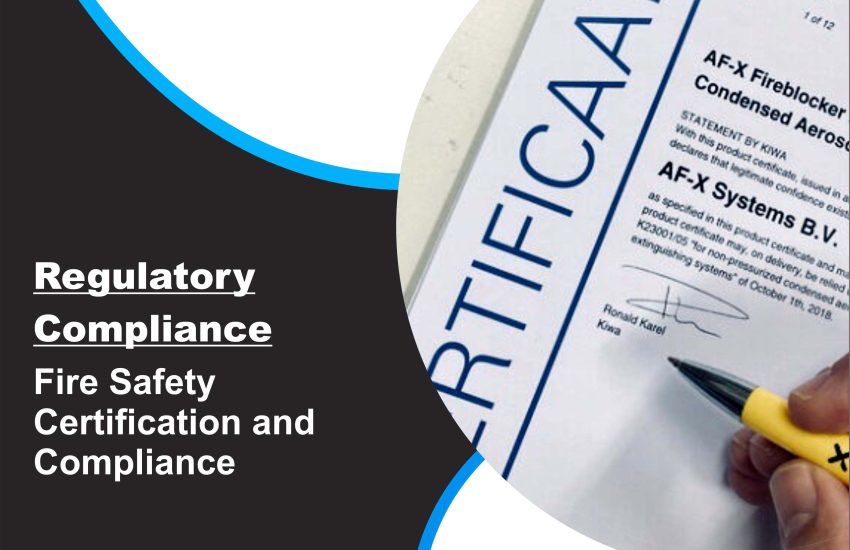Fire Safety Certification and Compliance are critical components in ensuring the protection of life, property, and the environment. Whether you are managing a commercial building, residential property, industrial facility, or public space, meeting fire safety standards is not just a legal obligation—it’s a moral responsibility.
In this article, we’ll explore what fire safety certification entails, why compliance is essential, how to obtain certification, and the consequences of non-compliance. We’ll also look at the various authorities involved and provide tips to help you stay compliant.
What Is Fire Safety Certification?
Fire safety certification is an official document issued by an accredited authority, confirming that a building or property meets specific fire safety regulations and standards. This certification demonstrates that the premises have undergone fire risk assessments and that necessary fire protection systems, procedures, and equipment are in place.
Common types of fire safety certificates include:
- Fire Risk Assessment Reports
- Fire Alarm System Certificates
- Emergency Lighting Certificates
- Sprinkler System Certification
- Fire Extinguisher Service Certificates
- Fire Safety Compliance Certificate (for regulatory approval)
Why Fire Safety Compliance Matters
Compliance with fire safety regulations is crucial for several reasons:
- Legal Obligation: Non-compliance may result in penalties, fines, or closure of premises.
- Life Safety: Proper fire systems can save lives during emergencies.
- Insurance Requirements: Many insurers require valid fire safety certification to issue or renew policies.
- Reputation Protection: Demonstrating compliance improves trust with employees, tenants, and the public.
Key Elements of Fire Safety Compliance
To be fully compliant, properties must address several key areas:
1. Fire Risk Assessment
Regular and comprehensive assessments identify fire hazards, evaluate risks, and propose mitigation strategies.
2. Fire Detection and Alarm Systems
Smoke detectors, heat sensors, and manual call points must be installed and regularly tested.
3. Firefighting Equipment
Buildings must have accessible fire extinguishers, fire blankets, and sprinkler systems—each with regular maintenance and service records.
4. Emergency Lighting
Escape routes and exits must be clearly lit with battery-backed emergency lights in case of power failure.
5. Evacuation Procedures
Documented and practiced evacuation plans, with assigned fire wardens, are mandatory.
6. Training and Drills
Staff must receive regular training on fire safety procedures and participate in scheduled fire drills.
How to Obtain Fire Safety Certification
Obtaining certification typically involves the following steps:
- Hire a Competent Fire Safety Professional: They will carry out the fire risk assessment and inspect existing systems.
- Implement Required Measures: Install or upgrade systems as per recommendations.
- Submit Documentation: Provide all inspection and maintenance reports.
- Undergo Audit or Inspection: Fire safety officers or third-party inspectors verify compliance.
- Receive Certification: If all standards are met, certification is issued.
Regulatory Authorities and Standards
Different regions may have their own codes and regulatory bodies. Common frameworks include:
- NFPA (National Fire Protection Association) – widely used in the U.S.
- BS 5839 and BS 5266 – British Standards for fire alarms and emergency lighting
- International Building Code (IBC)
- Local Fire Departments or Building Authorities
Consequences of Non-Compliance
Failing to meet fire safety standards can result in:
- Hefty fines and legal prosecution
- Closure of business operations
- Increased risk of fire damage and loss of life
- Insurance claim denials
Tips to Ensure Continuous Compliance
- Schedule regular fire risk assessments
- Keep maintenance records updated and accessible
- Provide ongoing fire safety training
- Test fire alarms and emergency lights monthly
- Review and update evacuation plans as the building or occupancy changes
Conclusion
Fire safety certification and compliance are not optional—they are essential for legal operation, safety assurance, and long-term risk management. By understanding your responsibilities and taking proactive steps, you can ensure that your premises remain compliant and safe for all occupants.


